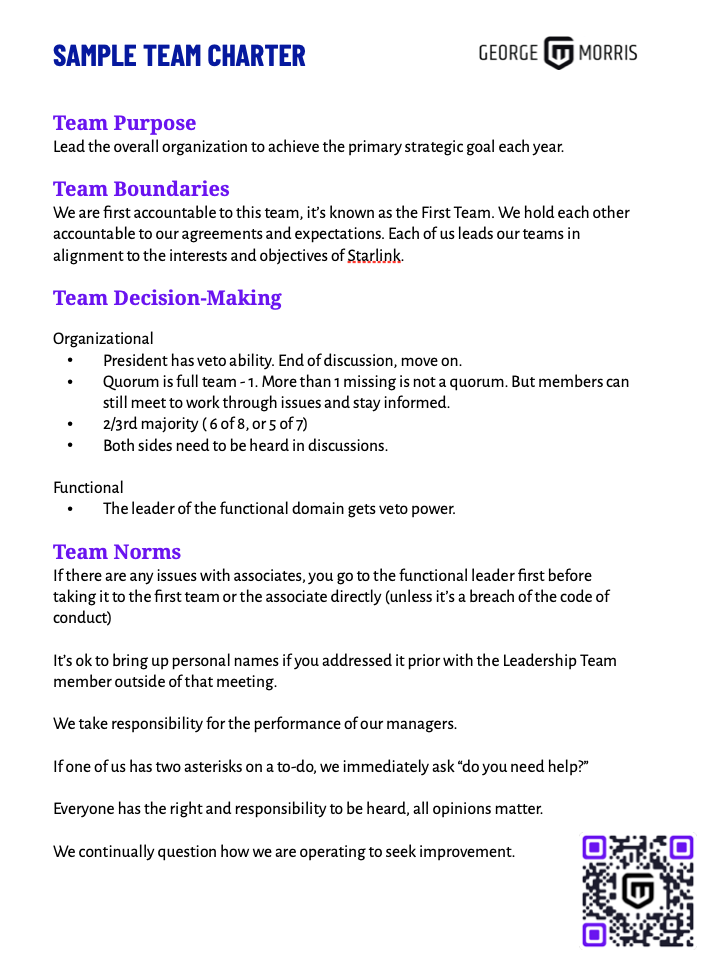Creating an Executive Team Charter
Receive infrequent tools, workshops and articles related to growing your business!
A Costly Miscommunication
In September 1999, NASA's Mars Climate Orbiter approached the Red Planet after a 286-day journey across 416 million miles of space. Its mission was to study Mars' climate and atmosphere. As the spacecraft neared Mars, it was supposed to slip into orbit around the planet. Instead, it vanished. Days later, a NASA investigation revealed a startling truth: the orbiter had disintegrated in Mars' atmosphere, burning up like a meteor.
The cause? A simple miscommunication between two teams.
One team, Lockheed Martin Astronautics in Denver, used English units (pounds-force) in its calculations. The other team, at NASA's Jet Propulsion Laboratory in Pasadena, assumed the data was in metric units (newtons). This small discrepancy caused the spacecraft to approach Mars at the wrong angle, flying too close to the planet's atmosphere. The result was catastrophic. A $125 million spacecraft was lost, along with years of work and the potential scientific discoveries it might have made. The total mission cost, including the launch vehicle and operations, amounted to $350 million - all gone due to a simple failure in team alignment and communication.
John Casani, chairman of the NASA review board, summed it up best: "The problem here was not the error, it was the failure of NASA's systems engineering, and the checks and balances in our processes to detect the error. That's why we lost the spacecraft."
This incident, now known as the "metric mix-up," stands as a strong reminder of the importance of clear communication and alignment within and between teams. It demonstrates how even the most technologically advanced projects can fail due to basic misunderstandings.
While your company may not be launching interplanetary missions, the lesson remains the same: without proper team alignment and clear communication protocols, even the most talented groups can fail spectacularly.
Enter the Team Charter - a tool that's often overlooked in the corporate world.
Think of a Team Charter as the benchmark of what you expect and will tolerate as a team. It answers questions like: Why does our team exist? What are we trying to achieve? How will we work together? Who's responsible for what?
Yet despite their importance, Team Charters are rarely used, and the result is a bunch of "hidden expectations" that never are voiced and hinder our ability to effectively communicate.

Why are Team Charters so important?
- Clarity of Purpose
They ensure everyone understands why the team exists and what it's trying to achieve. No more working at cross-purposes. - Defined Roles
They spell out who's responsible for what, reducing confusion and overlap. - Decision-Making
They establish how decisions will be made, preventing paralysis or power struggles. - Conflict Resolution
They provide a framework for handling disagreements before they escalate. - Accountability
They set clear expectations for performance and behavior.
So why are Team Charters often overlooked? Many leaders assume their team already knows these things and others fear the process will be time-consuming or lead to conflict. Some simply don't know where to start.
Would you start a road trip without a map? Build a house without blueprints? Launch a rocket without a flight plan? Of course not. So why would you lead a team without a Charter?
How to Build a Team Charter
Creating a Team Charter doesn't have to be complicated. Start by gathering your team and asking some questions to get the team thinking about their collective experiences. This entire process typically take less than 2 hours for most teams of 6 to 8 people.
FACILITATOR: Here are a few priming questions I like to use; have them write their answers down on paper:
- What was the best team experience you've had (any team), and what made it such a great team?
- What was the worst team experience you've had and why was it so bad?
- Thinking of the best examples of team (such as sports, business etc) which do you admire and why?
FACILITATOR: Once everyone has written their responses, now ask them to openly share some of what they wrote, be sure to engage everyone in the room. Once complete, you can now start gathering information to build the charter.
FACILITATOR:
- For each of these sections below, ask the question first, give the team a few minutes to consider their response and write them down on post-it notes.
- The Facilitator should write the heading on a whiteboard or large Post-It for the team members to stick their responses under.
- One by one invite each member to the board to read their Post-it and stick it to the wall. For each subsequent team member ask them to create clusters as necessary of similar responses, this will help the entire team see what items are most shared amongst the team members.
- The Facilitator should create a clean sheet to transcribe the stated responses. Start with the one with the most Post-its and work backwards to the smallest cluster. For each cluster read out what you see that cluster representing, ask for agreement from the team before transcribing it to the new sheet.
- Small clusters are items which team members hadn't thought about, or didn't find important. Be sure to mine these for majority agreement or conflict.
Purpose
FACILITATOR: What is the purpose of this team, specifically?
Example: Our mission is to lead the wind-energy industry by maximizing shareholder value and ROI
Example: Lead the organization to achieve the primary strategic goals each year.
Inclusion & Expulsion
FACILITATOR: How does one become part of this team? What's the criteria for joining? Is there a voting process? What about expulsion? What key roles must be represented on our executive team?
Example: You must be a member of this company for at least 3 months.
Example: 80% "yes" is the required vote to join this team.
Example: Any member, aside from the President. can be excluded from this team by a 2/3rds vote.
Decision-Making
FACILITATOR: How are decisions made at the organizational level and department levels?
Example: Without a quorum this team has no ability to make company decisions. A quorum is an attendance of 70% of leadership team.
Example: No one has veto power.
Expectations, Norms & Commitments
FACILITATOR: What is expected of each other as part of this team? How do we handle conflict here and with our teams?
Example: Come prepared to meetings and/or admit that you haven't prepared. It's better to say you aren't prepared and own it, than it is to fake it.
Example: We openly acknowledge our own failures.
Example: We commit to getting back to each member of this leadership team in less than 36 hours during the work week.
Example: Be present in the meeting. Keep your eyes in the meeting. Cameras on and no distractions.
Performance & Accountability
FACILITATOR: How will this team hold itself accountable? What is expected about your performance as an executive on this team?
Example: We are the "First Team" and you are accountable to this team over the team that reports to you.
Example: It's the job of each member of this team to call out any actions which seem contrary to the functioning of this team.
Example: All team members are expected to engaging in our meetings.
Example: Lateness to meetings will not be tolerated. Be here 5 mins before the meeting officially starts.
Confidentiality & Communications
FACILITATOR: How will we effectively communicate as a team? Are there tools we must use? What are the expectations in response time?
Example: We approach difficult conversations with sensitivity, preferring face-to-face interaction or video calls.
Example: Everything within the first team is confidential and stays within the first team unless specifically agreed to take the message outside the team.
Example: Team members will not be expected to reply to anything outside of work hours, weekends or while on vacation.
Meeting Structure
FACILITATOR: How often will we meet? Are there different types of meetings? What will be our default agenda?
Example: You are expected to enter your metrics before the start of the meeting.
Example: Full define an issue you are bringing to this team and the outcome you are looking for.
Example: We will follow the Scaling Up Weekly Meeting format but each section will be timed, and times are not flexible.
Example: If a to-do is late, we don't change the date of the to-do, we give it an asterisk. Three or more asterisk require discussion with the entire team and then redefinition of the to-do.
Example: Once the group makes a decision you are expected to commit to that decision and not undermine or subvert the decision.
Deliverables
FACILITATOR: What are the most critical outputs for this team to produce?
Example: EBDITA, Rocks, Goals, Strategy, Financial Plan, Building Infrastructure, Stability for associates, De-hassling
Example: Creating an execution plan and delivering on the plans.
Core Values
FACILITATOR: What are our non-negotiable values of this team? Are the building on the organizational values?
Example: Disrespect will not be tolerated.
Example: Each member of this team is an exemplar of the organizational values.
Updating the Charter
FACILITATOR: How will we handle changes to the Team Charter?
Example: Changes will be put to vote during our meetings. If there is 2/3rds agreement the change will be added to the Team Charter as a live working document.
Print & Sign
FACILITATOR: Once the session is done, transcribe the notes onto a shared digital document like Google Docs, so team members can easily make changes during the meetings. For added impact, print out one copy of the charter and ask all team members to sign it, showing their commitment.


